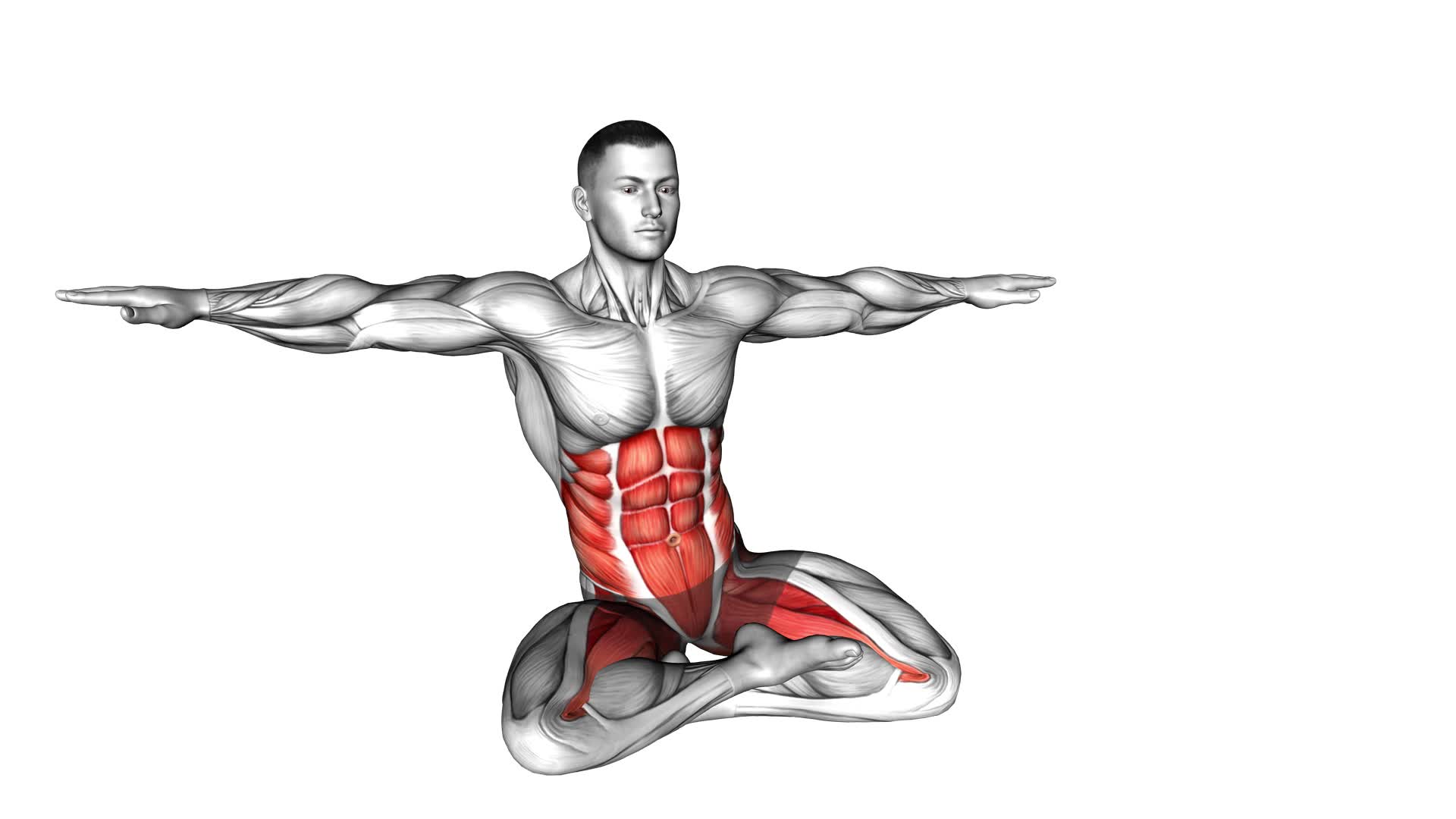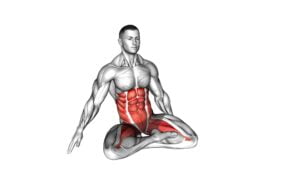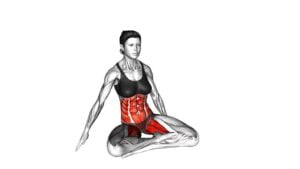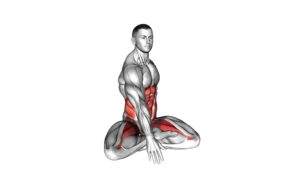Sitting Lotus Pose Hip Horizontal Rotation (VERSION 2) – Video Exercise Guide & Tips

Are you looking for an effective exercise to release tension in your hips and improve flexibility? Look no further than the Sitting Lotus Pose Hip Horizontal Rotation.
Watch This Exercise Video
In this video exercise guide, we will walk you through the steps to perform this pose correctly and provide tips to maximize your results.
With our detailed instructions and helpful tips, you'll be able to incorporate this exercise into your routine and experience the benefits of improved hip mobility.
Key Takeaways
- Sitting lotus pose hip horizontal rotation improves flexibility and increases range of motion in the hips.
- Engaging in this exercise engages muscles in the hips, thighs, and lower back, helping to improve posture and reduce lower back pain.
- Proper warm-up and preparation are essential to avoid injury and maximize the benefits of this pose.
- Practicing conscious breathing and maintaining proper alignment are important for performing the rotation smoothly and enhancing the results.
Benefits of Sitting Lotus Pose Hip Horizontal Rotation
Experience the numerous benefits of Sitting Lotus Pose Hip Horizontal Rotation. This exercise not only improves flexibility through the sitting lotus pose, but it also enhances your meditation practice with hip rotation. By incorporating hip rotation into the lotus pose, you can achieve a deeper stretch and increase range of motion in your hips.
When you practice Sitting Lotus Pose Hip Horizontal Rotation, you're actively engaging the muscles in your hips, thighs, and lower back. This helps to increase flexibility in these areas, allowing for greater ease of movement. As you rotate your hips in the lotus pose, you're also releasing tension and tightness in the hip joints, which can lead to improved posture and reduced lower back pain.
Furthermore, incorporating hip rotation into your lotus pose can enhance your meditation practice. By engaging the muscles in your hips, you're able to maintain a more stable and grounded position, allowing for a deeper state of relaxation. The gentle movement of the hips also helps to release any stagnant energy, allowing for a more focused and clear mind during meditation.
In conclusion, Sitting Lotus Pose Hip Horizontal Rotation offers a multitude of benefits, including improved flexibility and an enhanced meditation practice. By incorporating this exercise into your routine, you can experience the physical and mental benefits it provides.
Now let's transition into the next section, where we'll discuss how to prepare for this exercise.
Preparing for the Exercise
To prepare for the exercise, you'll need to gather a comfortable cushion or yoga mat to sit on. This will provide support and cushioning for your hips during the hip horizontal rotation. Once you have your cushion or mat ready, you can move on to the preparation techniques and warm-up exercises.
Before starting the sitting lotus pose hip horizontal rotation, it's important to warm up your body to prevent any injuries. Begin by performing some gentle stretches, such as neck rolls, shoulder rolls, and wrist stretches. These will help to loosen up your upper body and prepare it for the upcoming movement.
Next, focus on warming up your hips. You can do this by performing hip circles or hip rotations. Stand with your feet shoulder-width apart and gently rotate your hips in a circular motion. This will help to increase the flexibility and mobility of your hip joints.
Additionally, it's beneficial to perform some seated forward bends to further stretch and warm up your hips. Sit on the edge of your cushion or mat with your legs extended in front of you. Slowly hinge forward from your hips and reach towards your toes. Hold the stretch for a few breaths before releasing.
Step-by-Step Guide to Performing the Pose
Now that you're ready to perform the Sitting Lotus Pose Hip Horizontal Rotation, let's focus on some key alignment tips to help you execute the pose correctly.
Maintaining proper alignment is crucial to maximize the benefits and prevent any potential injuries.
Additionally, we'll discuss common mistakes to avoid, ensuring that you get the most out of this exercise.
Alignment Tips for Pose
Position your hips in proper alignment for the Sitting Lotus Pose by following these step-by-step instructions.
First, find a comfortable seated position on your mat. Place your right foot on top of your left thigh, and your left foot on top of your right thigh. Make sure your knees are close to the ground and your spine is straight.
Next, engage your core muscles to support your back and maintain a neutral pelvis. This will help to prevent any strain on your lower back.
If you're a beginner or have tight hips, you can modify the pose by sitting on a folded blanket or bolster to elevate your hips.
Remember to listen to your body and only go as far as feels comfortable for you.
With these alignment tips and modifications, you can confidently practice the Sitting Lotus Pose.
Common Mistakes to Avoid
Avoid these common mistakes when performing the Sitting Lotus Pose to ensure proper alignment and prevent strain on your body.
One common mistake is forcing your body into the pose without proper warm-up and preparation. This can lead to strain or injury in your hips and knees.
Another mistake is slouching or rounding your spine while in the pose. This not only compromises your alignment but also puts unnecessary pressure on your lower back. It's important to keep your spine straight and your shoulders relaxed throughout the pose.
Lastly, avoid placing your feet too close to your body or too far away. Finding the right distance will help maintain stability and balance in the pose.
Common Mistakes to Avoid
To prevent injury and maximize the benefits of the Sitting Lotus Pose Hip Horizontal Rotation (VERSION 2), it's important to be mindful of your body's alignment and avoid common mistakes. Here are three common mistakes to watch out for when performing this pose:
- Improper alignment: One of the most common mistakes is failing to maintain proper alignment. Make sure your spine is straight, your shoulders are relaxed, and your hips are level. Avoid slouching or leaning to one side, as this can strain your lower back and lead to discomfort or injury.
- Forceful movements: Another mistake to avoid is using excessive force or momentum during the rotation. Remember, this pose is meant to be a gentle stretch for your hips, not a vigorous exercise. Slow and controlled movements are key to avoid putting unnecessary stress on your joints.
- Ignoring your body's limits: It's important to listen to your body and respect its limits. Pushing yourself too hard or trying to achieve a deeper rotation than your body is ready for can lead to strain or injury. Start with small rotations and gradually increase the range of motion as you become more comfortable and flexible.
Tips for Maximizing Results
To get the most out of the Sitting Lotus Pose Hip Horizontal Rotation (VERSION 2), it's essential to focus on your breath and maintain a steady rhythm throughout the movement. By doing so, you can maximize your flexibility and improve your balance.
First and foremost, deep breathing helps relax your muscles and allows for a greater range of motion. As you inhale, imagine your breath flowing into the area of your hips and pelvis, expanding and opening up the joints. As you exhale, release any tension or tightness you may feel. This conscious breathing technique will enhance your body's ability to perform the rotation smoothly and efficiently.
Additionally, maintaining a steady rhythm is crucial for maximizing the benefits of this exercise. By moving in a controlled and fluid manner, you engage your muscles more effectively and reduce the risk of injury. Avoid rushing through the movement or forcing your body into positions it isn't ready for. Take your time, listen to your body, and gradually increase the intensity as your flexibility and balance improve.
Remember to be patient with yourself as you work on maximizing your results. Flexibility and balance are skills that can be developed over time with consistent practice. By incorporating these tips into your routine, you'll be well on your way to achieving a deeper stretch, increased flexibility, and improved balance in your Sitting Lotus Pose Hip Horizontal Rotation (VERSION 2).
Variations and Modifications for Different Levels
Now let's explore some variations and modifications for different levels in the sitting lotus pose hip horizontal rotation.
If you're a beginner, there are beginner-friendly modifications that can help you ease into the pose and build strength gradually.
On the other hand, if you're at an advanced level, there are variations that can challenge you and take your practice to the next level.
Additionally, if you have any physical limitations, there are ways to adapt the pose to accommodate your needs and ensure a safe practice.
Beginner-Friendly Modifications
Make modifications to the sitting lotus pose to accommodate different levels of experience. Whether you're a beginner or looking to improve your flexibility, there are various modifications you can try.
- Cross-legged position: If sitting in the lotus pose is challenging, start by sitting cross-legged. This position provides a stable base and allows you to gradually work towards the full lotus pose.
- Half lotus pose: Begin by placing one foot on the opposite thigh, while keeping the other foot grounded. This modification reduces the strain on the hips and knees, making it more accessible for beginners.
- Use props: If you have tight hips or limited flexibility, use props such as bolsters or blocks to support your knees and hips. This allows you to maintain a comfortable and stable position while practicing the sitting lotus pose.
Advanced Level Variations
Try incorporating advanced level variations to challenge yourself and further enhance your sitting lotus pose.
These advanced modifications will push you to overcome new challenges and take your practice to the next level.
One advanced variation you can try is the Half Lotus Pose, where you only place one foot on top of the opposite thigh while keeping the other foot on the ground. This requires more flexibility and balance, as you're working with a smaller base of support.
Another advanced modification is the Bound Lotus Pose, where you interlace your fingers behind your back while in full lotus pose. This variation increases the stretch in your hips and shoulders, while also challenging your upper body strength.
By incorporating these advanced variations, you'll continue to grow and progress in your practice.
Now, let's transition into the subsequent section about adapting for physical limitations.
Adapting for Physical Limitations
How can you modify the sitting lotus pose to accommodate physical limitations at different levels? Adapting for injuries and modifying for pregnancy are important considerations when practicing the sitting lotus pose. Here are three ways to adapt the pose for physical limitations:
- Use props: If you have knee or hip injuries, sitting on a bolster or folded blanket can provide support and reduce strain on your joints. Placing blocks under your knees can also help alleviate discomfort.
- Modify the position: If you're pregnant or have limited flexibility, you can modify the lotus pose by sitting cross-legged instead. This variation allows for more comfort and stability while still providing the benefits of a seated meditation posture.
- Try alternative poses: If the sitting lotus pose is too challenging, you can explore other seated poses like the easy pose or the half lotus pose. These variations offer similar benefits while being more accessible for those with physical limitations.
Frequently Asked Questions
Can Sitting Lotus Pose Hip Horizontal Rotation Help With Back Pain?
Sitting lotus pose hip horizontal rotation can definitely help with back pain. By incorporating this modification into your practice, you're able to target and release tension in the hip and lower back area.
The gentle rotation of the hips helps to improve flexibility and mobility, alleviating any discomfort or stiffness. Additionally, this movement stimulates blood flow and brings nourishment to the muscles, promoting overall well-being.
Incorporating hip rotation into your sitting lotus pose can be a beneficial way to address back pain.
Is It Safe to Practice This Pose During Pregnancy?
During pregnancy, it's important to prioritize your safety and comfort. While yoga can be beneficial during pregnancy, it's crucial to modify poses to accommodate your changing body.
When considering the sitting lotus pose hip horizontal rotation, consult with your healthcare provider and a qualified prenatal yoga instructor. They can guide you on safe modifications and help you reap the benefits of yoga during pregnancy, such as improved flexibility, stress reduction, and preparation for childbirth.
How Long Should I Hold the Pose for Maximum Benefits?
To get the maximum benefits from the pose, it's important to hold it for an appropriate duration.
The length of time you hold the pose will depend on your comfort level and flexibility.
Typically, holding the sitting lotus pose for at least 30 seconds to a minute can help improve hip flexibility and promote relaxation.
However, if you're a beginner, it's best to start with shorter durations and gradually increase as you become more comfortable.
Remember to listen to your body and never push yourself beyond your limits.
Can This Pose Improve Flexibility in the Hips?
Improving hip mobility and increasing range of motion are the main benefits of this pose. By practicing Sitting Lotus Pose with Hip Horizontal Rotation, you can enhance the flexibility in your hips. The rotation movement helps to loosen up the hip joint and stretches the surrounding muscles.
This pose targets the hip muscles, allowing them to become more supple and adaptable. Regular practice can lead to improved hip mobility and a wider range of motion in your hips.
Are There Any Precautions I Should Take Before Attempting This Pose?
Before attempting this pose, there are a few precautions you should take.
First, make sure you're warmed up and your body is ready for the movement.
Second, listen to your body and only go as far as is comfortable for you.
If you have any pre-existing hip injuries or conditions, it's best to consult with a healthcare professional before attempting this pose.
Lastly, if you find it difficult to maintain the pose, feel free to make modifications to better suit your body.
Conclusion
Incorporating the sitting lotus pose hip horizontal rotation into your exercise routine can offer numerous benefits, such as increased hip flexibility and improved posture.
By following the step-by-step guide and avoiding common mistakes, you can maximize the results of this pose.
Additionally, variations and modifications are available for different levels, ensuring that everyone can reap the rewards of this exercise.
So grab a mat, find a comfortable seated position, and start rotating those hips for a healthier body.

Author
Years ago, the spark of my life’s passion ignited in my mind the moment I stepped into the local gym for the first time. The inaugural bead of perspiration, the initial endeavor, the very first surge of endorphins, and a sense of pride that washed over me post-workout marked the beginning of my deep-seated interest in strength sports, fitness, and sports nutrition. This very curiosity blossomed rapidly into a profound fascination, propelling me to earn a Master’s degree in Physical Education from the Academy of Physical Education in Krakow, followed by a Sports Manager diploma from the Jagiellonian University. My journey of growth led me to gain more specialized qualifications, such as being a certified personal trainer with a focus on sports dietetics, a lifeguard, and an instructor for wellness and corrective gymnastics. Theoretical knowledge paired seamlessly with practical experience, reinforcing my belief that the transformation of individuals under my guidance was also a reflection of my personal growth. This belief holds true even today. Each day, I strive to push the boundaries and explore new realms. These realms gently elevate me to greater heights. The unique combination of passion for my field and the continuous quest for growth fuels my drive to break new ground.







